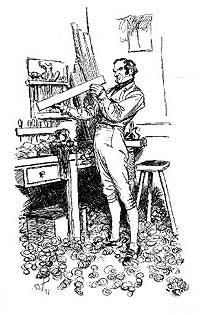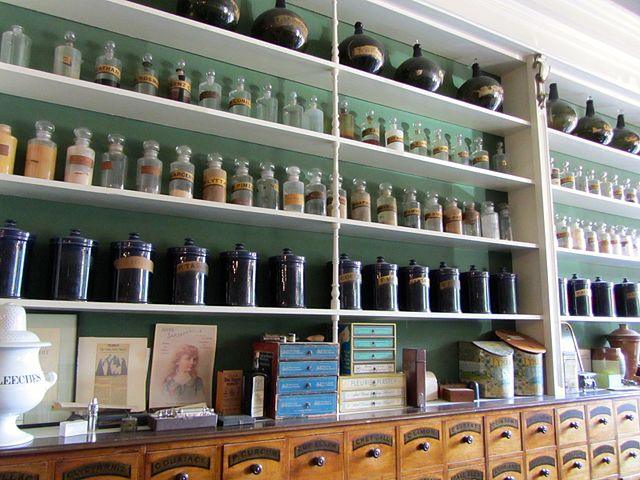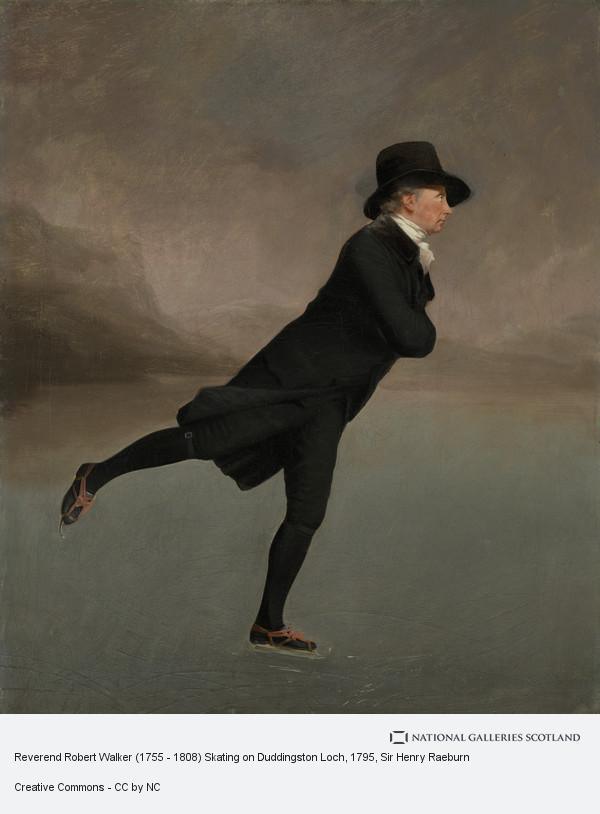
The Carpenter
Captain Harville was no reader; but he had contrived excellent accommodations, and fashioned very pretty shelves, for a tolerable collection of well-bound volumes, the property of Captain Benwick. His lameness prevented him from taking much exercise; but a mind of usefulness and ingenuity seemed to furnish him with constant employment within. He drew, he varnished, he carpentered, he glued; he made toys for the children; he fashioned new netting-needles and pins with improvements; and if everything else was done, sat down to his large fishing-net at one corner of the room.
Persuasion
The following article is from "The Book of Trades, or Library of Useful Arts" published by Jacob Johnson, in 1807, with the original copper plate engraving.

There is no art more useful than that which is exercised by the carpenter. It is his business to cut, fashion, and join timber and other wood for the purpose of building. There are several kinds of carpenters: but the term is usually applied to those who perform the rough work in the building of houses; such as hewing out, and putting in their places, the beams, rafters, joists, &c.: and those who do the lighter kind of work, as the making of doors, wainscoting and sashes, are called joiners: most of those, however, who are brought up to the trade are both carpenters and joiners.
The wood which they principally make use of is deal, oak, elm, and mahogany. Deal is the wood of the fir tree, and is chiefly brought from Sweden, Norway and other Northern European countries. The most common species of fir trees are the silver-leafed, and the pitch, or Norway, or spruce fir. The first of these grows in many parts of Germany, from whence turpentine is sent into England; but the most beautiful are those that grow on mount Olympus. The Norway fir produces the white deal commonly used by carpenters: from this pitch is also drawn; when it takes its second name. Oak is too well known in this country to need any description; it is chiefly used by ship-builders, of who we shall speak hereafter. Mahogany is a species of cedar: it is a native of the warmer parts of America, growing plentifully in the islands of Cuba, Jamaica, and Domingo. In some instances these trees grow to so large a size, as to be capable of being cut into planks of six feet in breadth: they rise to immense heights, notwithstanding they are sometimes found growing on rocks where there is scarcely any depth of earth.
The carpenter stands in need of a great variety of tools, such as saws, planes, chisels, hammers, awls, gimlets, &c. Common workmen are obliged to find their own tools, a set of which is worth from ten to twenty pounds, or even more. But for different kinds of mouldings, for beads, and fancy work, the master carpenter supplies his men with the necessary implements. The practices in the art of carpentry and joinery are called planing, sawing, mortising, scribing, moulding, &c. The great difference in the trades of a carpenter, and a joiner, is, that the former is employed in the larger, stronger, and coarser operations, and the latter in the smaller and more curious works.

The carpenter in the plate is represented in the act of planing the edge of a board, that is held in to the side of the bench by means of a screw which is always attached to it. On his bench ar the hammer, pincers, mallet, and the two chisels; a box also containing the turkeystone with which he sharpens his tools: the shavings taken off by his plane are scattered on his bench and on the ground: at the right hand corner stand some boards, and his bag in which he carries his tools: on the other side is the saw, upon the four-legged stool which he uses for various purposes.
Behind him is a new door, some other boards, a saw hanging against the wall, and a basket in which he puts his smaller tools. He is represented preparing boards to lay upon the roof of a new house in the back ground. The rafters are already in their places: the boards are to be laid next, in order to receive the slates. The art of sawing, and the different kinds of saws made use of, will be described when we come to speak of the sawyer. A mortise is a kind of joint, in which a hole of a certain depth is made in the thickness of a piece of wood, in order to receive another piece called a tenon.
Scribing is a term made use of when one side of a piece of stuff is to be fitted to the side of some other pieces which is not regular. To make the two join close together all the way, the carpenter scribes it; that is, he lays the piece of stuff to be scribed close to the other piece he intends to scribe it to, and opens his compasses to the greatest distance the two pieces any where stand from each other; then bearing one of the legs against the side to be scribed to, with the other led he draws a line on the stuff to be scribed. Thus he gets a line on the irregular piece parallel to the edge of the regular one; and if by a saw, or other instrument, the wood be cut exactly to the line, when the two pieces are put together they will make a neat joint.
Planing consists of taking off, as occasion may require, all the rough edges from wood, boards, &c. A plane consists of a piece of boxwood, very smooth at the bottom, serving as a stock, or shaft; in the middle of which is an aperture for a steel edge, or very sharp chisel, to pass. This edge is easily adjusted by a stroke of the hammer at one of the ends of the stock. Planes have different names, according to their forms, sizes, and uses; as the Jack-plane, which is about eighteen inches long, and intended for the roughest kind of work: The long-plane is two feet in length: it smoothes the work after the rough stuff is taken off: it is one of this kind that the carpenter in the plate is represented using, and it is well adapted for smoothing the edges of boards that are to be joined: The smoothing-plane is only six or seven inches long, and is used on almost all occasions. The rabbet-plane cuts the upper edge of a board straight or square, down into the stuff, so that the edge of another, cut after the same manner, may join with it on the square. Besides these there are the ploughing-planes, moulding-planes, round-planes, hollow-planes, snipes’-bill-planes, &c.
Glue is a very important article in the carpenter’s and joiner’s trade. It is made of the skins of all kinds of beasts, reduced to the state of jelly; and the older the animal, the better is the glue that is made of its hide. A ship-carpenter is an officer at sea, whose business consists in having things in readiness for keeping the vessel in which he is stationed, in repair; and in attending to the stopping of leaks, to caulking, careening, and the like. He is to watch the timber of the vessel, to see that it does not rot; and in time of battle he is to have everything prepared for repairing and stopping breaches made by the enemy’s cannon. A journeyman carpenter, when he works by the day, receives from three shillings and sixpence to four shillings and sixpence a day.
Enjoyed this article? If you don't want to miss a beat when it comes to Jane Austen, make sure you are signed up to the Jane Austen newsletter for exclusive updates and discounts from our Online Gift Shop.



1 comment
ipad 3 pris…
The Carpenter – Jane Austen Centre…
ipad 3 pris
Leave a comment
This site is protected by reCAPTCHA and the Google Privacy Policy and Terms of Service apply.